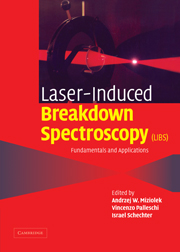Book contents
- Frontmatter
- Contents
- List of contributors
- Preface
- 1 History and fundamentals of LIBS
- 2 Plasma morphology
- 3 From sample to signal in laser-induced breakdown spectroscopy: a complex route to quantitative analysis
- 4 Laser-induced breakdown in gases: experiments and simulation
- 5 Analysis of aerosols by LIBS
- 6 Chemical imaging of surfaces using LIBS
- 7 Biomedical applications of LIBS
- 8 LIBS for the analysis of pharmaceutical materials
- 9 Cultural heritage applications of LIBS
- 10 Civilian and military environmental contamination studies using LIBS
- 11 Industrial applications of LIBS
- 12 Resonance-enhanced LIBS
- 13 Short-pulse LIBS: fundamentals and applications
- 14 High-speed, high-resolution LIBS using diode-pumped solid-state lasers
- 15 Laser-induced breakdown spectroscopy using sequential laser pulses
- 16 Micro LIBS technique
- 17 New spectral detectors for LIBS
- 18 Spark-induced breakdown spectroscopy: a description of an electrically generated LIBS-like process for elemental analysis of airborne particulates and solid samples
- Index
- References
10 - Civilian and military environmental contamination studies using LIBS
Published online by Cambridge University Press: 08 August 2009
- Frontmatter
- Contents
- List of contributors
- Preface
- 1 History and fundamentals of LIBS
- 2 Plasma morphology
- 3 From sample to signal in laser-induced breakdown spectroscopy: a complex route to quantitative analysis
- 4 Laser-induced breakdown in gases: experiments and simulation
- 5 Analysis of aerosols by LIBS
- 6 Chemical imaging of surfaces using LIBS
- 7 Biomedical applications of LIBS
- 8 LIBS for the analysis of pharmaceutical materials
- 9 Cultural heritage applications of LIBS
- 10 Civilian and military environmental contamination studies using LIBS
- 11 Industrial applications of LIBS
- 12 Resonance-enhanced LIBS
- 13 Short-pulse LIBS: fundamentals and applications
- 14 High-speed, high-resolution LIBS using diode-pumped solid-state lasers
- 15 Laser-induced breakdown spectroscopy using sequential laser pulses
- 16 Micro LIBS technique
- 17 New spectral detectors for LIBS
- 18 Spark-induced breakdown spectroscopy: a description of an electrically generated LIBS-like process for elemental analysis of airborne particulates and solid samples
- Index
- References
Summary
Introduction
Laser-induced breakdown spectroscopy (LIBS) has demonstrated its capability in quantitative determination of elemental composition in various samples in laboratories for decades. Recently, the interest in applying LIBS to detect various hazardous materials in the environment has grown rapidly. This chapter reviews some recent work related to environmental contamination studies using LIBS. Two portable LIBS instruments developed for field application are described in this chapter. The first instrument has been used by the US Army Research Laboratory to analyze the contaminated soil from Army sites and also for other geological applications. The other system was used by Mississippi State University to detect the resources conservation and recovery act (RCRA) metals in the off-gas of industrial plants and in liquids. The practical problems with LIBS application in environmental application such as calibration and sensitivity are also discussed in this chapter. The concept of using a new generation of broadband spectrometers to improve LIBS' capability in monitoring multiple emission lines of the same element to improve the detection limit and other signal enhancement techniques is addressed. The initial result of LIBS application in environmental problems is encouraging. We believe that the performance of LIBS in environmental application will continuously improve with the commercial development of various components in LIBS detection system.
LIBS is a chemical sensor technology with a capability for real-time in situ analysis that was first demonstrated in the laboratory over two decades ago and is now at the threshold of widespread commercialization.
- Type
- Chapter
- Information
- Laser Induced Breakdown Spectroscopy , pp. 368 - 399Publisher: Cambridge University PressPrint publication year: 2006



